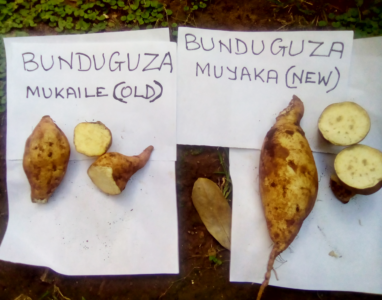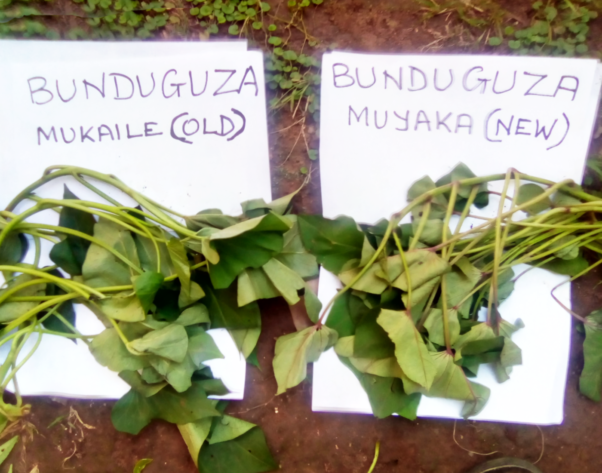What’s in a name? And when is a name just a name?
In Busoga region of eastern Uganda, the names for two morphologically similar varieties offer insights to researchers on how they can help breeders develop better sweetpotatoes for small farmers and consumers.

The name of the first variety – Bunduguza – is a one-word description of the numerous roots produced by this sweetpotato cultivar. This variety has two versions – old and new, muyaka and mukaile – and both produce many roots but can be distinguished by their skin color. Apart from the abundant roots, both versions feature high dry matter, which households prefer for making mugoyo – a very popular mash of boiled beans and sweetpotato.
The second variety – Kipapali – means the “pawpaw” because the flesh color resembles the pawpaw fruit. Consumers enjoy Kipapali for its nutritional content delivered through the orange-flesh of the variety, good for vision and child development. People in eastern Uganda are familiar with these nutritional ideas thanks in large part to partner organizations working with the International Potato Center, including Volunteer Efforts for Development Concerns (VEDCO) and HarvestPlus.
Most varieties are released with a name derived from the research station in which they were developed. These names are helpful to the breeders and researchers, but not to the end users: the farmers, traders and consumers. When in the market, these sweetpotato varieties are often given local names and these names can vary from village to village, leading to multiple names for the same variety. While this all may seem potentially very confusing, there is valuable information contained in these local monikers. Understanding the meanings of these local names can help researchers identify the attributes that are important and breed new varieties to meet those needs and desires.
Also, cataloguing the various names for new varieties can help breeders when they need to discover the true genetic identity of a sweetpotato and avoid potential duplications in germplasm collections. This clarity is essential for developing effective seed systems so farmers can be assured they are getting the variety they want and seed producers are producing the preferred variety.

However, problems with new varieties arise when traders combine older seed potato with other varieties for sale. They will mix available and low-price varieties with consumer-preferred varieties and some genetic mixing occurs in the process.
This kind of name and genetic detective work is ongoing right now in Uganda, where researchers are working with sweetpotato seed producers in Kamuli and Iganga to match market-preferred varieties (with local names) to the varieties with their original research names. Bunduguza has been matched with Dimbuka Bukulula (or NAROSPOT 1). Kipapali has been identified with traits comparable to NASPOT 8 and NASPOT 13.
Meanwhile, work continues to develop better varieties and cleaner seed to produce higher yields for small farmers in Uganda. The National Crops Research Resource Institute (NaCRRI) is hosing demonstration trials to evaluate the performance of newly-developed varieties against market-preferred varieties. Stella Namazzi, a sweetpotato seed business development officer with NaCRRI says, “This work provides seed producers with market intelligence on which varieties will be popular, so that they can plan their multiplication accordingly.”
Acknowledgement:
This study was undertaken as part of the CIP-led project: SweetGAINS (Sweetpotato Genetic Advances and Innovative Seed Systems). We acknowledge the support of Namusubo Rehema Edith, a vine multiplier in Bulamogi, Iganga, who introduced us to Hajira Natatya, the farmer who explained the two Bunduguza varieties in her field. Both parties agreed to share their photos for this article.
Bonny Oloka
Research Officer, Plant Breeding, Quantitative Genetics and Seed Systems
Root Crops Program
National Crops Resources Research Institute (NaCRRI)
Stella Namazzi
Sweetpotato Seed Business Development Officer (NaCRRI)
Sam Namanda
Associate Scientist
International Potato Center, Uganda
